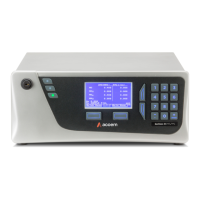Calibration Port
The calibration port can be connected to the span/zero sources. It is recommended that a gas
dilution calibrator (Ecotech’s Serinus Cal 2000) be used with a cylinder of ammonia (NH
3
) and
nitrogen oxide (NO) to deliver precise concentrations of NH
3
and NO. The GPT function of the gas
dilution calibrator will also be required for testing the converter efficiency.
Note: All connections to this port should not exceed ambient pressure. A vent is required for excess
span gas.
Exhaust Port
The exhaust port is where the reacted sample, calibration gases, background air and bypass flows are
exhausted from the instrument. The exhaust port should be connected to the vacuum pump using ¼”
OD tubing. The P030004 240V vacuum pump (P030005 110V) available from Ecotech, should be used
to provide the required vacuum and flow for one Serinus 44 analyser.
CAUTION
Ammonia & Oxides of nitrogen are toxic gases. It is recommended that exhaust
air is expelled into an unoccupied area, as it contains trace levels of oxides of
nitrogen. The exhaust must be a suitable distance from the sample inlet to avoid
influencing the ambient measurements.
Background Port
The background port is used to supply air to the ozone generator via the dryer within the instrument.
Auxiliary in port
The Auxiliary In port (AUX In) brings air in from the external converter to the N
X
path. Tubing from
the outlet of the external converter is connected to the Aux in port on the instrument.
Auxiliary out port
The Auxiliary Out port (AUX Out) takes sample air from the instrument and delivers it to the external
converter. Tubing is connected to the inlet of the external converter from the AUX Out port.
2.3.2 Power Connections
CAUTION
When connecting the mains power to the instrument, the following must be
adhered to otherwise the safety and the reliability of the instrument may be
compromised.
A three pin mains power lead with a protective earth conductor MUST be used.
The mains power outlet (wall socket) must be in the range of 100-240 VAC, 50 to 60 Hz.
The mains power outlet must be protected by an earth leakage protection circuit.

